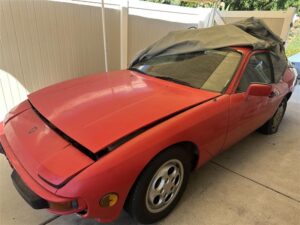
This 1987 Porsche 924 VIN Verification was done by our team member in Riverside, Ca. on 10-04-2025

This 1987 Porsche 924 VIN Verification was done by our team member in Riverside, Ca. on 10-04-2025
The 1987 Porsche 924 is a front-engine, rear-wheel-drive sports coupe that offered a unique combination of Porsche handling and affordability. That year marked the continuation of the improved 924 S model, which borrowed engineering and performance upgrades from the more expensive Porsche 944, offering significantly better performance than earlier 924 variants.
Originally introduced in 1976, the Porsche 924 was designed as an entry-level Porsche using a combination of in-house development and Volkswagen-sourced components. Its goal was to bring more people into the Porsche brand without the high costs associated with the 911. By the mid-1980s, Porsche responded to criticisms of the early 924’s underpowered engine by introducing the 924 S, which featured a detuned version of the 944’s 2.5L inline-4 engine.
The 1987 model year retained the improvements of the S variant, offering better power output, upgraded braking, and refined handling, bringing the 924 closer in line with Porsche’s sports car legacy. Production of the 924 S continued through 1988, after which the 924 series was discontinued.
Engine:
2.5-liter inline-4 cylinder engine (shared with the Porsche 944 but slightly detuned)
Single overhead cam (SOHC)
Displacement: 2,479 cc
Performance:
Horsepower: Approximately 158 hp @ 5,900 rpm
Torque: Around 155 lb-ft @ 4,500 rpm
0–60 mph: Approximately 8.2 seconds
Top Speed: About 137 mph
Redline: Approximately 6,400 rpm
Transmission:
5-speed manual transmission (standard)
3-speed automatic transmission (optional)
The 1987 924 S used Porsche’s transaxle layout for near-perfect 50/50 weight distribution, making it a confident-handling car for both street and track driving.
Exterior Design:
Classic hatchback coupe body style
Retractable pop-up headlights
Rounded, aerodynamic shape with a long hood and short rear deck
Lightweight construction with a curb weight around 2,700 lbs
15-inch alloy wheels (varied styles depending on trim or options)
Interior Features:
Simple, driver-focused cockpit layout
Cloth or optional leatherette sport bucket seats
Analog instrumentation with center-mounted tachometer
Fold-down rear seats to expand cargo space
Manual windows and mirrors (power available on some models)
Optional sunroof and air conditioning
For 1987, Porsche primarily offered the 924 S variant in the U.S. and most global markets. Differences between models were primarily based on optional features rather than distinct trim levels.
Notable Options Included:
Leather upholstery
Upgraded stereo systems
Limited-slip differential
Sunroof
Air conditioning
Power accessories (windows, mirrors)
There were no special edition trims for the 1987 model year, but minor regional differences in emissions and equipment may apply.
The 1987 Porsche 924 S featured basic safety equipment by modern standards, but it met or exceeded the requirements of its time.
Safety Features:
Front crumple zones integrated into the body design
3-point seatbelts for front passengers
Rear lap belts
Energy-absorbing steering column
Side-impact reinforcement beams in the doors
High-strength steel unibody construction
Technology:
Analog gauges with comprehensive instrumentation
Optional cassette stereo with equalizer
No airbags or electronic driver assists (common for the era)
Despite its performance capabilities, the 924 S was relatively fuel efficient for a sports coupe.
Estimated Fuel Economy (Manual Transmission):
City: ~18–20 mpg
Highway: ~30–32 mpg
Combined: ~24–26 mpg
These figures could vary depending on driving style, maintenance condition, and optional equipment (e.g., air conditioning, automatic transmission).
In 1987, the Porsche 924 S competed against a number of affordable sports cars, both in Europe and North America.
Key Rivals:
| Model | Comparison |
|---|---|
| Porsche 944 | More power and refinement, but higher price tag |
| Datsun/Nissan 300ZX | More power, especially in turbo form; heavier handling |
| Toyota Supra (Mk3) | More luxury and tech, but less balanced handling |
| Mazda RX-7 (FB/FC) | Lighter and more agile, but less daily usability |
| BMW E30 3-Series | More upscale interior and rear seat space, less sporty |
The 924 S found a sweet spot as a lightweight, well-balanced, and affordable way into Porsche ownership without the expense or complexity of the 911.
Original MSRP (1987):
Around $20,000 to $23,000 USD, depending on options
Positioned between entry-level Japanese sports cars and more expensive European competitors
Current Market Values (as of 2025):
Fair Condition: $5,000 – $8,000
Good Condition: $8,000 – $13,000
Excellent/Low-Mileage Examples: $14,000 – $20,000+
Values vary widely based on mileage, originality, maintenance history, and regional demand
Due to its increasing recognition as a classic Porsche, well-preserved 924 S models are slowly appreciating in value.
Praised in period reviews for its excellent balance, responsive steering, and improved engine performance over earlier 924s
Recognized as one of the most accessible and practical Porsches to own and maintain
Frequently included in lists of “Best Budget Porsches” or “Underrated Classic Sports Cars” by enthusiast media
Increasingly appreciated among collectors for its blend of Porsche DNA and affordability